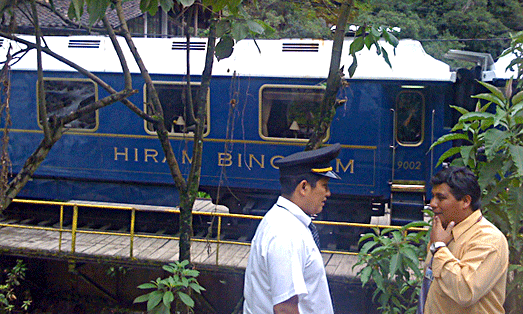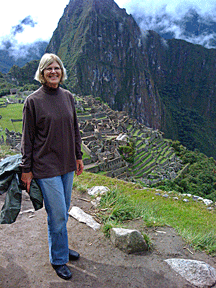| |
Hotel Monasterio, in Cuzco, is a converted sixteenth century monastery. Halls open onto a central courtyard of flowerbeds and lawns inside the two-story exterior walls. Gregorian chants waft through the hotel, and paintings of saints and angels adorn the walls. With its arched facades and terra-cotta tiled roof, it takes us back in time..
At check-in we are given some “mate de coca” tea to help combat altitude sickness. Made from the leaves of the coca tree, it is illegal to bring home to the US, as this leaf is the source of cocaine distilled for illegal drug trafficking.
Lunch is served on the patio of the hotel.
Later, while we are touring the city and nearby Inca ruins, the predictable headaches and exhaustion from the altitude catch up with us. By the time we return to the hotel I’m nauseated and have trouble breathing. My husband Joe calls the front desk; they send up an oxygen tank and a pot of mate de coca tea. I sleep for a few hours, but awake feeling achy. My mind is going to strange places, too.
“Perhaps I will not be able to see Machu Picchu after waiting so long,” I mumble. I’m hot and shaking.
“My one regret, if I were to die today, is that I would never have seen Machu Picchu. So I might as well stick it out and it will be all worth it no matter what.”
At breakfast, after some yogurt and fresh papaya juice, I drink another cup of mate de coca and begin to feel better. Today, it’s Machu Picchu or bust.
| |
 |
|
| |
Hiram Bingham train at Poray Station. Note the Orient Express Company's trademark tiny table lamp next to the windows. |
|
Our first stop will be the Poroy train station. Our driver takes us up steep narrow streets, passing children in school uniforms, dogs wandering about, and a woman selling fruit on the side of the street. Another woman, along with her unleashed herd dog, is walking several pigs tied with individual rope harnesses.
At a little over 13,000 feet, the Poroy station is lively with brightly outfitted dancers keeping time to an Andean tune played on an air flute.
Travelers to Machu Picchu have choices of transportation. There are no airplanes flying in, but helicopter service is available for the extremely wealthy. Or one could spend three or four days hiking in. But getting there by train is the easiest and most sensible way to go.
There are three trains: a plain Backpacker train, the more upscale Vista Dome train, and the luxury Hiram Bingham train that leaves Poroy (about a 20-minute drive from Cuzco and 13 degrees south of the equator) at the civilized hour of 9 AM. This service is run by Peru Rail, a company member of Orient Express. The train is named after Hiram Bingham, the American who re-discovered the lost city of Machu Picchu in 1911 after it was hidden by jungle for centuries.
We board and are escorted to reserved seats at a table for two, set with a white linen tablecloth, a single yellow rose bud, and elegant silverware and china. The train’s interior is warm, luxurious, and inviting. In the style of the 1920s Pullman trains, it features lots of polished wood.
Brunch, with many courses, is leisurely, taking most of the morning to complete, and features an abundant variety of fresh fruits and juices. The Peruvian produce is outstanding in variety and flavor. While we are feeling much better, the altitude is still affecting our appetites, so we go lightly on champagne, omelets, meats, and desserts.
A handsome couple at the next table speak German to each other, English to the Americans, and Spanish to the Peruvians. They live in New York.
The train climbs past farms, along lush river valleys, and below monumental mountain peaks. Beside the tracks are brightly dressed women walking with llamas. Soon the terrain changes to jungle, with wild fuchsias, hydrangeas, and impatiens among tall trees, ferns and vines.
Our guide, Gary, points out scenic points and tells us about the history of the Inca people. Peru has 85% of the world’s climate types, and we are seeing most of them. Corn and potatoes of many varieties grow in the valleys and terraced hillsides. The track follows the Urubamba River that flows past Machu Picchu and joins the Amazon in Brazil. The train trip takes about three and a half hours.
At Aguas Calientes, having dropped down to an altitude of 6,500 feet, we de-train. While porters carry our bags, we enjoy a five-minute walk through a noisy, colorful outdoor market where vendors of fruits, vegetables, crafts, and paintings are all calling out at once. Across the street, next to a waterfall, a bus awaits. It takes us up the winding narrow road to the 8,000-foot altitude of Machu Picchu.
The narrow road up the hill from Aguas Calientes is crowded with sightseeing busses. There are tour groups speaking French, German, Japanese, and English.
| |
 |
|
And at last, here we are! Machu Picchu immediately exceeds my expectations. Everything seems amazingly vertical – photos do not portray the steep changes in altitude within the terraced park itself, nor how majestic it is. In a narrow saddle between two steep mountain peaks, it overlooks the Urubamba River 2,000 feet below. Spread over five square miles, it contains challenging stairways (over 3,000 steps in all) of uneven stones with nothing to hold onto for balance. We stop for photos ops and email the pictures directly to our amazed family back home. There are temples, terraced hillside farms, and schools. We explore ritual sites and living quarters left by the industrious Incas who built this beautiful city, then mysteriously disappeared in the 1400s.
While it is possible to overnight in Aguas Calientes, the bustling town a short bus ride away, we stay two nights at the only (and very expensive) hotel here, the Macchu Picchu Sanctuary Lodge, near the ruins, where we enjoy a room with a mountain view and a terrace. |
|
| |
Edy Henderson at Machu Picchu Photo by Joe Henderson |
|
|
|
| |
|
|
| |
I highly recommend the hotel’s High Tea. (This is beginning to sound like an article for a food magazine, but – in spite of our altitude-challenged appetites -- it is hard to sing enough praise for the outstanding food Peru offers.)
As we begin our return journey, we board the bus back to Aguas Calientes, and stop to bargain with a vendor for two air flutes.
Back at the train station an onboard services gentleman in an elegant navy blue poncho hands us damp wash-cloths so we can cleanse our hands, and asks us to follow him to our seats. Boarding for the 4 PM trip back to Cuzco, we find ourselves sitting across from the same multi-lingual couple we met earlier, and others we’d met hiking around the ruins. Other passengers are mostly affluent older couples and families.
Providing carriages that seat 42 people, with tables for two or four, the train is painted blue and gold. The staff dresses formally in white shirts, black bow ties, black pants (or skirts) and black jackets.
The waitress takes our orders for the main course. Soon Pisco Sours, served in clay-stemmed vessels, arrive. This tasty national drink combines white grape brandy, lime juice, and sugar topped with whipped egg whites. Wine is served with the various courses, too.
Before dusk falls we see trekkers and their Inca porters carrying their supplies.
This makes us happier than ever that we’ve chosen the comfort and luxury of this train to be pampered and well taken care of.
I sample each course of our five-course gourmet dinner but cannot come close to finishing my plate. All of the food is native to Peru. The first course is delicious, although I’m not sure what I’m eating.
The second course is a kiwicha pancake with apple and celery salad. (Fields of kiwicha and quinoa, both used as grains, can be seen along the way.) Alpaca ham mousse is a bit strong , but the warm tomato gazpacho with green toast made from basil croutons is tasty. Clean forks arrive with Joe’s entrée of salmon. I go vegetarian with the most delicious tomato pasta sauce on earth.
Although it is now too dark to see out the window, we feel the train reverse direction as it enters switchbacks. It slows moves forward, then we reverse again. This continues for a half hour as an ubiquitous air flute provides background music.
As we reach Cuzco it is completely dark. Our guide, Gary, escorts us out of the train, makes sure we have connected with our ride, and bids us goodbye.
Relaxed, though exhilarated, we are fully satisfied.
Indeed, the Hiram Bingham train enhanced the dream of a lifetime!
IF YOU GO: My husband Joe booked this trip for my birthday. You, or your travel agent, may contact the Orient Express company to book it at www.orient-express.com. A US representative of the company may be reached at 1 800 524 2420, or email greatjourneys@oeh.com. |
|
Edy Henderson can be reached at Edymay@aol.com
|
|

